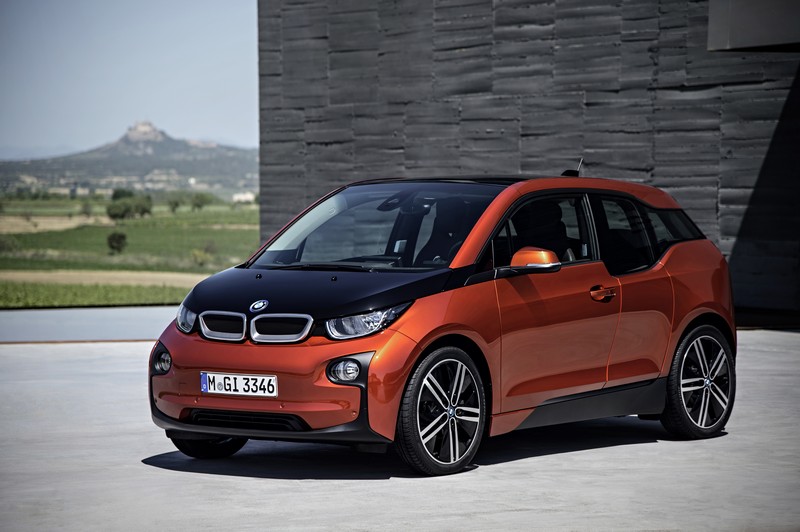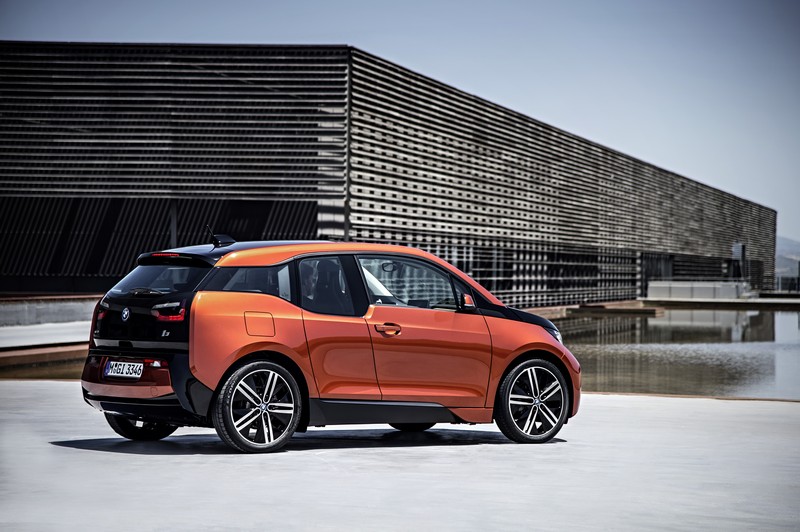
BMW today introduced the all-new BMW i3 electric car, constructed in a revolutionary way from next-generation materials. The BMW i3 will go on sale in Canada in the second quarter of 2014, debuting with a base MSRP of $44,950.
The new all-electric BMW i3 is a landmark in BMW’s mission to provide a completely sustainable, electric vehicle that still delivers the Ultimate Driving Experience. The BMW i3 is the first product of the new BMW i sub-brand, and is a truly purpose built electric car. It’s a new era for electro mobility at BMW.
The vehicle concept behind the BMW i3 was designed from the outset to incorporate an all-electric drive system. This has numerous advantages over “conversion” vehicles, in which the original combustion engine is swapped for an electric motor. The engineers can design whatever works best, in terms of construction, dimensions and configuration of the electric drive system’s components. The car’s development is dictated by the characteristics designed into the car by the development team and not by the constraints imposed by a pre-existing vehicle design. For example, the space in a conversion vehicle set aside for the fuel tank or exhaust system cannot be used. In the BMW i3 there is no need for this kind of compromise.
This leads to the LifeDrive architecture concept, which was purpose-built specifically for the BMW i3. It is comprised of two modules; the Life Module, and the Drive Module. Think of the Life Module as the passenger cabin, or greenhouse. It is the first-ever mass produced Carbon Fiber Reinforced Plastic (CFRP) passenger cell in the automotive business, and is a big factor in the cars efficiency. Carbon Fiber Reinforced Plastic is equally as strong as steel, while being 50% lighter, and 30% lighter than aluminum. The result is an electric car that weighs approximately 1195 kg (preliminary Canadian figures).
 Due to the lightweight, high tensile strength of CFRP, the passenger cell has added protection, and the battery has less work to do, which allows for the use of a smaller, lighter battery that saves even more weight, reduces charging time and increases range. The light weight design of the Life Module also lowers the BMW i3’s center of gravity, making it a more engaging and dynamic car to drive.
Due to the lightweight, high tensile strength of CFRP, the passenger cell has added protection, and the battery has less work to do, which allows for the use of a smaller, lighter battery that saves even more weight, reduces charging time and increases range. The light weight design of the Life Module also lowers the BMW i3’s center of gravity, making it a more engaging and dynamic car to drive.
The Drive Module, which is constructed out of 100% aluminum, consists of the 22-kWh, 204 kg. lithium-ion battery, electric drive train, MacPherson strut and 5-link rear suspension system and structural and crash components. The battery mounted in the rear, close to the drive wheels, gives impressive performance characteristics while also providing better traction.
Another benefit of the LifeDrive architecture concept is that there is no space-consuming transmission tunnel running through the center of the car, like in most internal combustion powered cars, because of the separate Drive Module. This gives the BMW i3 the interior space of the BMW 3 Series, while only having the footprint of the much smaller BMW 1 Series.
Even the vehicle’s key is sustainably manufactured. The source material of the new bio-polymer key is based on castor oil pressed from castor seeds. The owner’s manual is also made from renewable resources.
The interior is made using high quality renewable sources and recycled materials. The BMW i3 has the Next Premium interior, which blends sustainable resources with a premium feel for the same interior quality as the BMW 5 Series Sedan. 25% of the plastics in the interior and 25% of the thermoplastic parts on the exterior are made from either recycled materials or renewable sources.
According to studies carried out as part of BMW’s Project i, involving more than 1,000 participants and conducted over some 16 million kilometers, it was revealed that the average daily distance covered was around 50 kilometers. The BMW i3 will be able to travel 130 to 160 kilometers on a single charge. This can be increased by up to approximately 25% in ECO PRO mode and by the same amount again in ECO PRO+ mode.
Convenient charging is possible either with the home charging station offered by BMW i or at any public charging station that uses a Level 2 SAE J1772 charging system. DC fast charging, using the SAE DC Combo-Fast Charger, will be available as an option. From a public fast-charging station, it will provide an 80 percent charge from a fully depleted battery in just 30 minutes.
In order to reduce range anxiety, a rear-mounted 650cc, 34 hp, two-cylinder, gasoline-powered Range Extender generator is available, which roughly doubles the vehicle’s range. When the battery gets to a certain level, the Range Extender starts and maintains the battery’s current state of charge. The Range Extender never directly drives the vehicle’s wheels. The Range Extender adds roughly 150 kg to the vehicle curb weight and has a fuel capacity of 9.0 litres.
Since 1999, according to the DOE, average gasoline prices in America have increased from approximately 218%. In the same time, the pricing of electricity has increased from 6.6 cents to 9.9 cents, a change of only 50%, making electricity a far more attractive commodity from a pricing standpoint.
Photography courtesy of BMW Canada Inc.

























